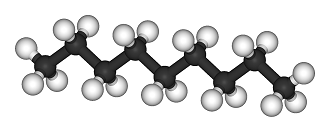Nonane

Nonane is an alkane with the chemical formula C9H20. As a hydrocarbon, it can undergo hydrocarbon combustion and can be burned as a fuel. Nonane is a volatile, colourless liquid that has a gasoline-like odour. Nonane, like other alkanes, is insoluble in water.[2]
Normally, nonane is obtained from refining petroleum. However, it can also be produced by adding hydrogen (H2), to nonene (a closely related organic molecule with the formula: C9H18), an alkene. This reaction is known as hydrogenation. Nonane is also a component in automotive and jet fuel. The second major use for nonane is as an ingredient in organic solvents. Since nonane is insoluble in water, it makes it a good solvent for other hydrophobic molecules.[3]
Properties
Below is a table of some of the basic properties of nonane.
| Chemical formula | C9H20 |
| Molar mass | 128.26 grams/mole |
| Melting point | -51oC[4] |
| Boiling point | 151oC[4] |
Combustion Reaction
Nonane undergoes hydrocarbon combustion, combining with oxygen to form carbon dioxide. The balanced chemical equation for the complete combustion of nonane is:
The hydrocarbon combustion reaction releases heat energy and is an example of an exothermic reaction. The reaction also has a negative enthalpy change (ΔH) value.
References
</translate>
- ↑ "Nonane-3D-balls". Licensed under Public Domain via Wikimedia Commons - http://commons.wikimedia.org/wiki/File:Nonane-3D-balls.png#mediaviewer/File:Nonane-3D-balls.png
- ↑ National Center for Biotechnology Information. (2015). Properties of Nonane [Online]. http://pubchem.ncbi.nlm.nih.gov/compound/nonane#section=Color [February 16,2015].
- ↑ Andrea Kropp. (2015). Nonane: Structure & Uses [Online]. Available: http://education-portal.com/academy/lesson/nonane-structure-uses.html [February 16, 2015].
- ↑ 4.0 4.1 Charles E. Ophardt. (2003). Virtual Chembook - Hydrocarbon Boiling Points [Online]. Available: http://www.elmhurst.edu/~chm/vchembook/501hcboilingpts.html [February 16,2015].
<languages />

